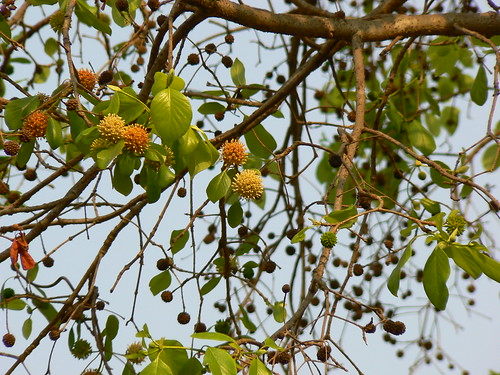
Botanical name: Mitragyna parvifolia (Roxb.) Korth.
Synonym: Stephegyne parvifolia Roxb.
Family: Rubiaceae (bedstraw, coffee, or madder family)
Common names of Mitragyna parvifolia:
Bengali: Gulikadam • English: Kaim • Hindi: कैम Kaim, Kayim, Kaddam Kamgi • Kannada: Kongu, Kadaga • Malayalam: Vimpu, Nirkkatampu, Rosu, Katampu • Marathi: कळम Kalam • Sanskrit: Vitanah • Tamil: Katampai, Nirkkatampu, Sinnakkatampu • Telugu: Nerkadamba • Thai: Kratom
Origin: India
A medium sized to large deciduous tree, reaches heights of 50 feet with a branch spread of over 15 feet, with rounded crown and light grey smooth bark exfoliating in small scales. The stem is erect and branching.
Leaves, dark green in color -- simple, opposite, very variable, elliptic, suborbicular or obovate, rounded, acute, glabrous on both sides, main nerves 6-8 pairs, stipules 13 by 5.8 mm.
Flower greenish yellow and grow in ball-shaped clusters, fragrant (reminds one of the better known Kadam flowers), in globose heads; fruits oblong capsules with 'blunt rounded tbp1; and blunt ribs.
Found throughout India, in deciduous and evergreen forests upto 1,200 m.
Medicinal use: The roots and bark are acrid, bitter, stomachic and febrifuge, and are useful in gastropathy, colic and fever. The leaves are acrid, bitter, sweet, styptic, vulnerary, stomachic, anti-inflammatory, anodyne depurative and febrifuge. They are useful in vitiated conditions of vata and kapha, internal and external haemorrhages, wounds, colic, flatulence, dyspepsia, inflammations, myalgia, skin diseases, leprosy, erysipelas and fever.
Courtesy:
- Flowers of India
Note: Identification or description may not be accurate; it is subject to your review.
Bild von dinesh_valke
Keine Kommentare:
Kommentar veröffentlichen